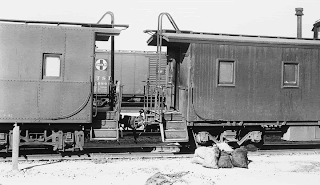As Mac Gaddis and others have told me, there would be a caboose supply building at any yard where cabooses were serviced. This might be part of an entire complex of small, mismatched and sometimes ramshackle buildings, and might even be a box car or other car body incorporated into the complex. There had to be storage space for all the supplies, and working space for the assigned employees. This kind of building would be painted Colonial Yellow with Light Brown trim.
The photo immediately below, taken at the West Oakland caboose track on October 11, 1946, shows two features. At left is a water tap, supported by and protected by a wood post (and note the Allied truck), and in front of the truck of caboose 205 (Class C-30-3) at right are several cloth bags of coal. This is how coal was supplied. (The R.W. Biermann photo is courtesy of Arnold Menke.)
The next photo is very informative. It shows two service carts, the one at right apparently battery powered. The one at left carries ice and bottled water, while on the one at right are cartons of Olin fusees and Texaco “hot box coolant.” This photo is from the Roseville caboose track in 1962, and is SP photo N-6514. The caboose at center is number 1191, Class C-40-3. Both these photos (cropped less severely) are in my caboose book (Southern Pacific Freight Cars, Vol. 2, Cabooses, Signature Press, Berkeley and Wilton, 2002).
My branch junction at Shumala has a caboose track, so I need to provide a small building for caboose servicing. An old box car body, perhaps one of the fine Westerfield models of early Harriman box cars, too old even to be in MOW service by 1953, might make a good choice. I’ll probably position a few bags of coal outside.
Tony Thompson


Tony,
ReplyDeleteThanks for covering another overlooked aspect of railroad operations. Provisioning for cabooses and their crews is not something one typically sees mentioned or modeled but it was part of everyday rail life while cabooses and full crews were used.
SP had a form S-4490 that lists the equipment for one caboose. This list includes the articles, quantity and storage location on the caboose. The list also specifies articles unique to certain divisions or type of caboose as well.
My copy of this list is from 9-60 and it lists Train Bucket 3-Gallon, 1 Gallon can of switchlight oil, 2 cartons of the Hot Box Coolant (Texaco), a 5 gallon Water Type Fire Extinguisher for Pool cabooses and a 1 pound dry chemical fire extinguisher for all cabooses. Other items of note include 24 10-minute red fusees, 36 torpedoes, a wash water tank and a wash basin.
Cabooses operating in Nevada had to carry a stretcher. Cabooses operating between Roseville and Sparks carried 12 spikes and a spike maul, while those operating on the Rio Grande and Salt Lake Divisions carried an oiling bucket with 20 pounds of soaked waste. I bet that smelled good.
My list includes 55 items that were to be checked and replenished by a "Caboose Checker" immediately upon arrival at terminal.
Greg Henschen
Thanks, Greg. The differences among divisions are illuminating. I know of the Form S-4490 because it was the basis for the interior restoration that Bob Church did on his caboose, SP 1063. Since he did his work while there was still a Sacramento Shops, he was able to "hang out" with some Shops employees and obtain authentic SP items for those equipment replacements. The caboose had finished its days on the Sacramento Division before retirement, and did have a stretcher, perhaps on account of that Nevada requirement. He wisely decided that "fireworks" items such as fusees would be best omitted from his caboose at home . There are interior photos of Bob's caboose in my Volume 2 on SP cabooses.
ReplyDeleteTony Thompson